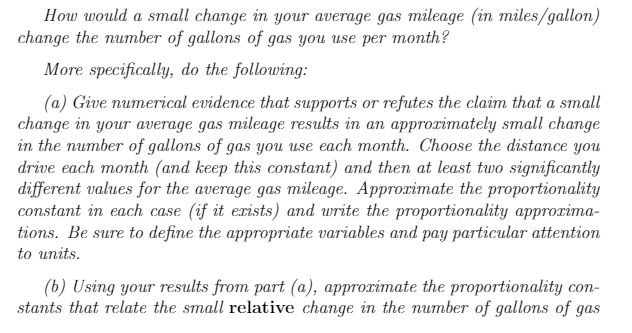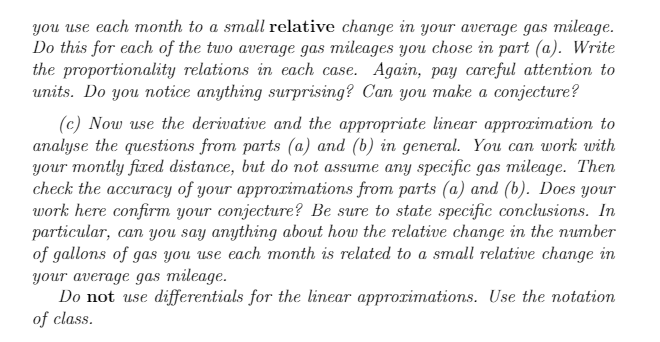Do you notice anything surprising? Cân you make a conjecture? (c) Now use the derivative and the appropriate linear approrimation to analyse the questions from parts (a) and (b) in general. You can work with your montly fixed distance, but do not assume any specific gas mileage. Ther check the accuracy of your approrimations from parts (a) and (b). Does you work here confirm your conjecture? Be sure to state specific conclusions. In particular, can you say anything about how the relative change in the numbe: of gallons of gas you use each month is related to a small relative change ir jour average gas mileage. Do not use differentials for the linear approximations. Use the notation
Do you notice anything surprising? Cân you make a conjecture? (c) Now use the derivative and the appropriate linear approrimation to analyse the questions from parts (a) and (b) in general. You can work with your montly fixed distance, but do not assume any specific gas mileage. Ther check the accuracy of your approrimations from parts (a) and (b). Does you work here confirm your conjecture? Be sure to state specific conclusions. In particular, can you say anything about how the relative change in the numbe: of gallons of gas you use each month is related to a small relative change ir jour average gas mileage. Do not use differentials for the linear approximations. Use the notation
Algebra & Trigonometry with Analytic Geometry
13th Edition
ISBN:9781133382119
Author:Swokowski
Publisher:Swokowski
Chapter7: Analytic Trigonometry
Section7.6: The Inverse Trigonometric Functions
Problem 91E
Related questions
Concept explainers
Rate of Change
The relation between two quantities which displays how much greater one quantity is than another is called ratio.
Slope
The change in the vertical distances is known as the rise and the change in the horizontal distances is known as the run. So, the rise divided by run is nothing but a slope value. It is calculated with simple algebraic equations as:
Question

Transcribed Image Text:How would a small change in your average gas mileage (in miles/gallon)
change the number of gallons of gas you use per month?
More specifically, do the following:
(a) Give numerical evidence that supports or refutes the claim that a small
change in your average gas mileage results in an approrimately small change
in the number of gallons of gas you use each month. Choose the distance you
drive each month (and keep this constant) and then at least two significantly
different values for the average gas mileage. Approrimate the proportionality
constant in each case (if it erists) and write the proportionality approxima-
tions. Be sure to define the appropriate variables and pay particular attention
to units.
(b) Using your results from part (a), approximate the proportionality con-
stants that relate the small relative change in the number of gallons of gas

Transcribed Image Text:you use each month to a small relative change in your average gas mileage.
Do this for each of the two average gas mileages you chose in part (a). Write
the proportionality relations in each case. Again, pay careful attention to
units. Do you notice anything surprising? Can you make a conjecture?
(c) Now use the derivative and the appropriate linear approrimation to
analyse the questions from parts (a) and (b) in general. You can work with
your montly fixed distance, but do not assume any specific gas mileage. Then
check the accuracy of your approrimations from parts (a) and (b). Does your
work here confirm your conjecture? Be sure to state specific conclusions. In
particular, can you say anything about how the relative change in the number
of gallons of gas you use each month is related to a small relative change in
your average gas mileage.
Do not use differentials for the linear approximations. Use the notation
of class.
Expert Solution
This question has been solved!
Explore an expertly crafted, step-by-step solution for a thorough understanding of key concepts.
Step by step
Solved in 2 steps with 1 images

Knowledge Booster
Learn more about
Need a deep-dive on the concept behind this application? Look no further. Learn more about this topic, advanced-math and related others by exploring similar questions and additional content below.Recommended textbooks for you

Algebra & Trigonometry with Analytic Geometry
Algebra
ISBN:
9781133382119
Author:
Swokowski
Publisher:
Cengage


Big Ideas Math A Bridge To Success Algebra 1: Stu…
Algebra
ISBN:
9781680331141
Author:
HOUGHTON MIFFLIN HARCOURT
Publisher:
Houghton Mifflin Harcourt

Algebra & Trigonometry with Analytic Geometry
Algebra
ISBN:
9781133382119
Author:
Swokowski
Publisher:
Cengage


Big Ideas Math A Bridge To Success Algebra 1: Stu…
Algebra
ISBN:
9781680331141
Author:
HOUGHTON MIFFLIN HARCOURT
Publisher:
Houghton Mifflin Harcourt

Functions and Change: A Modeling Approach to Coll…
Algebra
ISBN:
9781337111348
Author:
Bruce Crauder, Benny Evans, Alan Noell
Publisher:
Cengage Learning

Algebra for College Students
Algebra
ISBN:
9781285195780
Author:
Jerome E. Kaufmann, Karen L. Schwitters
Publisher:
Cengage Learning

Algebra and Trigonometry (MindTap Course List)
Algebra
ISBN:
9781305071742
Author:
James Stewart, Lothar Redlin, Saleem Watson
Publisher:
Cengage Learning